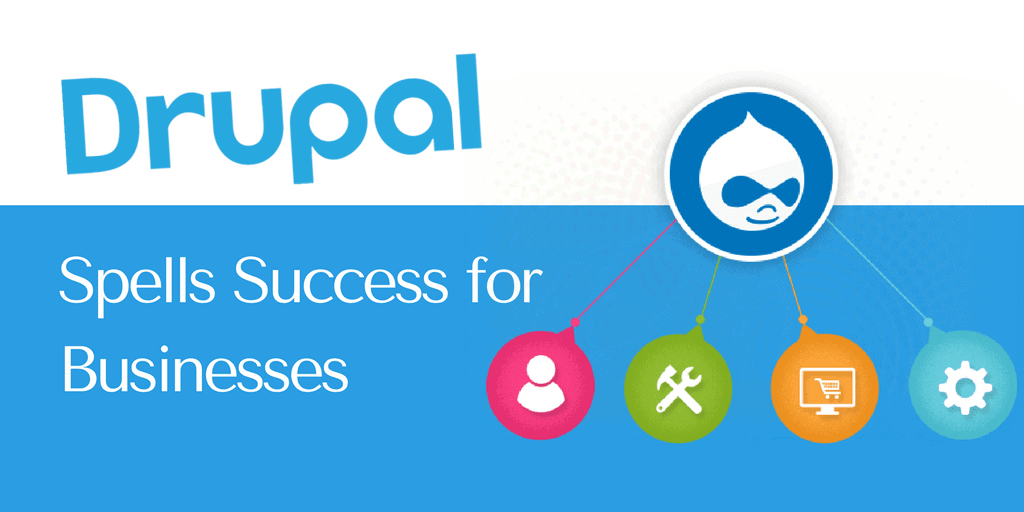
Drupal took off in 2000 as a message board and was converted to an open-source project one year later. Dries Buytaert initially wanted to name the site “durp.org” meaning “village” in Dutch, but mistakenly bought the domain “drop.org” instead. In time, he became so attached to this accidental name that he decided to name the upgraded version “Drupal” which is a rendering of “druppel” or “drop” in Dutch.
Since then, Drupal has constantly evolved and has a strong base of more than one million users. Among those are governmental organizations, top-notch presses, blooming businesses and over 100,000 active contributors. It is a fact that WordPress bypasses Drupal in popularity; but by far, no content management system (CMS) can beat Drupal in powering and securing high-traffic and data-heavy sites.
With the latest release of Drupal 8.2.5 in late 2016, the company has raised the bar for an amazing customer experience. It is not just about structuring and managing your website using defined instruments. Drupal offers almost unlimited tools for your ever-growing business. The winning tech nature of Drupal 8.2.5 is proven in its combination of well-crafted features and refurbished fundamentals.
1. Drupal is adaptive
If Drupal was a toy, it would be Lego. If Drupal was a CMS, it would be the most adaptive platform you’ve ever imagined. And it is.
To start, Drupal is the top deal in terms of scalability. Whether you expect to welcome constant streams of visitors or intermittent spikes, Drupal can stretch tirelessly and maintain smooth performance thanks to its multi-layered cache architecture. If you’ve ever wondered why there’s rarely a “traffic jam” on weather.com, grammy.com or economist.com, the contribution of Drupal can’t be ignored.
The platform also allows integration of digital applications. Users are free to furnish their online entities with cutting-edge tools and enjoy content shortcuts to other sites. Drupal’s focused application program interface (API) ensures that your business can actively participate in a constantly growing digital ecosystem.
The greatest perk is that your choices of business tools are almost infinite. As stated on its website: “Drupal doesn’t dictate to the business; the business dictates what it needs from Drupal.” Drupal is capable of turning any blueprint into reality. In fact, the platform has always successfully delivered what it promises: Tailored Business Solutions.
2. Drupal is agile
Drupal’s agility is proven via its highly secured sphere and well-coordinated features. The U.S. government has great trust in Drupal. The platform is the engine behind over 150 federal websites or 24% of all .gov websites, among which are the White House, NASA, the Departments of Education, Energy, Commerce, Health, Defense, Justice, Transportation, Homeland Security and Agriculture. Its client list is extended to security-focused corporations like PayPal, CNN, Time and The Economist.
Drupal is able to recruit such distinguished users by imposing strong coding standards and rigorous community code review processes. The major problem of open-source projects is the vulnerability of third party extensions and modules. Thus, to be a trusted contributor, one needs to survive a well-documented process under the scrutiny of Drupal security experts. On a regular basis, this international team works closely with core contributors to identify issues, release patches and direct mitigation. Drupal reinforces itself against the top 10 common risks in practice, listed in the Open Web Application Security Project, with outstanding features including encrypted, salted and repeatedly hashed passwords, highly granulated data encryption, data validation and data scrub by API, segmented user access control, login attempt limitation and IP ban to prevent brute force.
What you get from Drupal is not only a safe, but also a dynamic, ecosystem. Content authoring is facilitated by intuitive tools. Content creation, content editing, content revising, workflows, smart tagging and taxonomy are all accessible on mobile devices. Segmented user access control, more than just a security measure, also simplifies teamwork. This feature grants administrators complete control over cumulative and customizable accessibility of inferior roles. Together with flexible content architecture, i.e. smart-filtered and media-featured content display, Drupal makes a win–win situation for both site visitors and site managers. Even if you are operating several websites, multisite features are available for quick creation and deployment under a single admin account.
3. Drupal is mobile friendly
If your website doesn’t work on mobile devices, you have fallen behind your competition. Why? First, it’s what your customers want and expect from your business. A Google survey of 1,088 U.S. smartphone internet users found that 74% of visitors were likely to return to a mobile-friendly website, 61% would leave if the site doesn’t work on their mobile device, and 67% were prone to purchase from mobile-friendly sites. Second, considering that two-thirds of U.S. residents are using smartphones to seek information since 2015. Third, mobile shopping time is now exceeding laptop or PC shopping time, and the same goes for digital media time. In short, if you are not willing to go mobile, your competitors will serve your customers and enjoy the benefits.
Fortunately, it is Drupal’s top principle to ensure that your site is responsive, optimally displayed and easily managed across devices. Once again, it’s a win–win for both you and your visitors since all tasks can be completed on the go.
4. Drupal is insightful
Content is positioned as a core service at Drupal. To deliver a rich, flexible digital experience, the platform separates backend and frontend or content management and content display. The company describes this separation as a reusable, future-proof effort. Your content is detached from any technical constraint and always ready to adapt to contemporary trends. Vice versa, frontend developers can free their imagination. Node, Angular, Backbone and Ember are a few among various tools that can be employed to creatively construct interactive sites and apps. Drupal unleashes developers from regular CMS limitations. Reskin/Redesign site appearance becomes less of a hassle since the whole process is disengaged from content management.
In terms of technical support, your business is by no means alone. The Drupal community stays true to its nature of an open-source and jointed project. Users are willing to contribute improvements for the benefit of the whole network. Even the platform symbol is designed based on community ideas. So, your seemingly new and unique problems can be solved by more experienced users.
5. Drupal is an entirely multilingual platform, from backend to frontend.
For Drupal 8.2.5, 94 languages are available. Building multilingual websites targeting a global market with international teams is made easy by Drupal’s dynamic, language-based displays, multiple admin language and translation workflows. Drupal strives to be a competent translator for site administrators, site developers and especially visitors. Localized page layouts and elements can be adjusted in accordance with different languages.
As a CMS, Drupal 8.2.5 undoubtedly passes the winning-tech test. With great scalability, strong integration capability and unlimited choices of business tools, it is adaptive. With advanced security and dynamic authoring features, it is agile. With capability to serve both traveling developers and visitors, it is mobile friendly. With content-as-service principles, a strong user community and multilingual support, it is insightful.
Overall, Drupal is a mature and proven platform with a growing base of users and contributors. What businesses and organizations can expect from Drupal 8.2.5 is a powerful technology that magnifies success if leverage optimally. If your purpose is just to create a simple blog, Drupal is surely overwhelming since it requires a steep learning curve for proper navigation. But if what you have in mind is a truly out of the box solution, no candidate can perform better than Drupal. That’s also the idea behind its logo, a stylized drop with infinity-shaped eyes, a curved nose and a mischievous smile. Formulate your idea, and Drupal will adjust to fit your shape. There’s no end to its customization.











